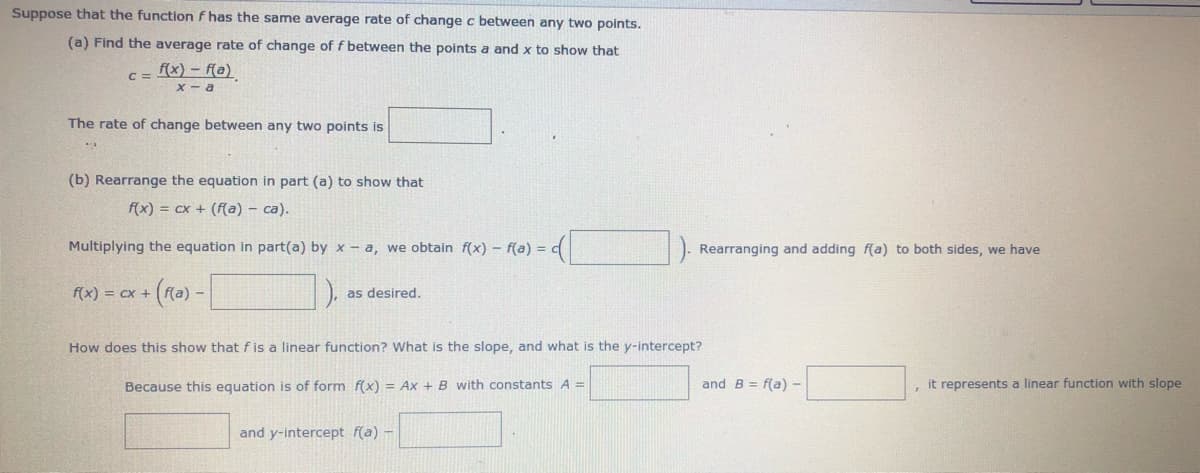Suppose that the function f has the same average rate of change c between any two points. (a) Find the average rate of change of f between the points a and x to show that c = x) – f(a) X - a The rate of change between any two points is (b) Rearrange the equation in part (a) to show that f(x) = cx + (f(a) - ca). Multiplying the equation in part(a) by x – a, we obtain f(x) - f(a) Rearranging and adding f(a) to both sides, we have (10) - f(x) = cx + as desired. How does this show that f is a linear function? What is the slope, and what is the y-intercept? Because this equation is of form f(x) = Ax + B with constants A = and B = f(a) - , it represents a linear function with slope and y-intercept f(a) -
Suppose that the function f has the same average rate of change c between any two points. (a) Find the average rate of change of f between the points a and x to show that c = x) – f(a) X - a The rate of change between any two points is (b) Rearrange the equation in part (a) to show that f(x) = cx + (f(a) - ca). Multiplying the equation in part(a) by x – a, we obtain f(x) - f(a) Rearranging and adding f(a) to both sides, we have (10) - f(x) = cx + as desired. How does this show that f is a linear function? What is the slope, and what is the y-intercept? Because this equation is of form f(x) = Ax + B with constants A = and B = f(a) - , it represents a linear function with slope and y-intercept f(a) -
Big Ideas Math A Bridge To Success Algebra 1: Student Edition 2015
1st Edition
ISBN:9781680331141
Author:HOUGHTON MIFFLIN HARCOURT
Publisher:HOUGHTON MIFFLIN HARCOURT
Chapter8: Graphing Quadratic Functions
Section: Chapter Questions
Problem 17CT
Related questions
Question
I’ve been trying to figure this out an I just can’t get it.

Transcribed Image Text:Suppose that the function f has the same average rate of change c between any two points.
(a) Find the average rate of change of f between the points a and x to show that
C = x) – (a)
X - a
The rate of change between any two points is
(b) Rearrange the equation in part (a) to show that
f(x) = cx + (f(a) - ca).
Multiplying the equation in part(a) by x - a, we obtain f(x) - f(a) =
Rearranging and adding f(a) to both sides, we have
f(x) = cx +
as desired.
How does this show that f is a linear function? What is the slope, and what is the y-intercept?
Because this equation is of form f(x) = Ax + B with constants A =
and B = f(a) -
, it represents a linear function with slope
and y-intercept f(a) -
Expert Solution
This question has been solved!
Explore an expertly crafted, step-by-step solution for a thorough understanding of key concepts.
This is a popular solution!
Trending now
This is a popular solution!
Step by step
Solved in 3 steps with 2 images

Recommended textbooks for you

Big Ideas Math A Bridge To Success Algebra 1: Stu…
Algebra
ISBN:
9781680331141
Author:
HOUGHTON MIFFLIN HARCOURT
Publisher:
Houghton Mifflin Harcourt

College Algebra
Algebra
ISBN:
9781305115545
Author:
James Stewart, Lothar Redlin, Saleem Watson
Publisher:
Cengage Learning

Algebra and Trigonometry (MindTap Course List)
Algebra
ISBN:
9781305071742
Author:
James Stewart, Lothar Redlin, Saleem Watson
Publisher:
Cengage Learning

Big Ideas Math A Bridge To Success Algebra 1: Stu…
Algebra
ISBN:
9781680331141
Author:
HOUGHTON MIFFLIN HARCOURT
Publisher:
Houghton Mifflin Harcourt

College Algebra
Algebra
ISBN:
9781305115545
Author:
James Stewart, Lothar Redlin, Saleem Watson
Publisher:
Cengage Learning

Algebra and Trigonometry (MindTap Course List)
Algebra
ISBN:
9781305071742
Author:
James Stewart, Lothar Redlin, Saleem Watson
Publisher:
Cengage Learning

Trigonometry (MindTap Course List)
Trigonometry
ISBN:
9781337278461
Author:
Ron Larson
Publisher:
Cengage Learning
